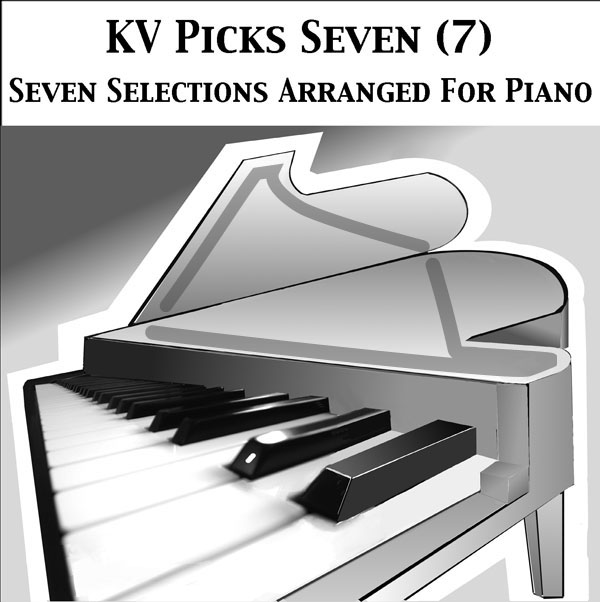Mid-year in 2005, my best friend, KV first suggested that I record a project to include seven (7) musical selections of his choice. As background, the number “7” is significant in a mock-superstitious (cross my fingers) fashion to my friend. It was not until several years ago that I finally realized the most significant aspect of the number “7” to KV was that #7 was the baseball jersey number of his favorite baseball player of all time, New York Yankee, Micky Mantle.
Each of these songs also has definite significance to me. I agreed to record his selections and intended to make the CD recording project his birthday gift for later that year (Sagittarian November).

I confess to being unduly prone to procrastination. Beginning the “KV Picks Seven (7)” project was no exception to my tendency to “think about” a task rather than beginning it. I am not making excuses as I recollect that my progress on the project was hampered by the slowness of the ancient computer I was using then. I did not complete the project for KV’s 2005 birthday as I had hoped. In the fall of 2006, I replaced my ancient “Beige G3 Mac” and obtained my current “Mac Pro™.” Finishing “KV Picks Seven (7)” was the first project on the then-new computer. Also new to me then were the Synthogy “Ivory” pianos. I re-recorded all these pieces (originally performed in 2005) using the Synthogy Ivory Bosendorfer piano.
The remarks below include my notes on each of these songs. I hope that you enjoy reading these personal reflections and listening to KV’s 2006 birthday present.
—Stan Owen, Jr.
1. Autumn Leaves (Joseph Kosma; English lyrics by Johnny Mercer)
I believe that KV first heard me play the then-well-known Roger Williams arrangement of “Autumn Leaves” during our 1969-1970 freshman year at Birmingham-Southern College. Unfortunately, during the subsequent years I lost the book containing the Roger Williams arrangement. The version of “Autumn Leaves” recorded for this collection is my arrangement. Its harmony is deliberately chromatic and exploits the combination of piano and backing “Strings” that are available in Synthogy Ivory.
Maybe, I will eventually return to this song to record Roger Willams’ version of it
2. Tammy (S. Owen, Jr.)
“Tammy” is one of my original compositions/sketches from the collection: “Girl Songs and Other Sketches” (1999).
Tammy was an attractive, young, travel-agent who befriended and assisted my Mother significantly while planning one or more of my Parents’ overseas trips. Despite my best efforts to attract Tammy’s attention, I was never successful. The song that I wrote for Tammy survives as the only thing remaining of our relationship. It has been very heartening to me that KV has always been graciously complimentary to me about this song. And, I have played various versions of it for him on the too-infrequent occasions that he visits nowadays.
I recently listened to the 1999 “Girl Songs” version of Tammy and realized that several portions of the original melody are altered, and even omitted in the version recorded in this collection. Better, worse? You’ll have to be the judge…
3. Jean (Rod McKuen)
I am certain that I first played “Jean” on the piano around 1969 and have played it many more times since then. KV owned the 1969 Oliver LP with the version of the tune which was used in the soundtrack to the film “The Prime of Miss Jean Brodie.” I believe that we were also aware of the composer, Rod McKuen — and, perhaps we were also familiar with his rendition. Or, KV’s appreciation for the song: “Jean” might also have been related to his memories of a high-school relationship with a young lady named “Jean.”
4. An Affair to Remember (Our Love Affair) (Warren / Adamson / McCary)
This song is the theme from the movie: “An Affair to Remember,” which starred Cary Grant and Deborah Kerr. The version of the song that I recorded was arranged by Carmen Cavallaro, who was a well known pianist, band-leader, and arranger of popular music (including movie music) during the 1940-50’s. It is said that he greatly influenced the then-young Liberace.
After watching the movie and listening to the piano version of the song in the movie, I believe that the arrangement recorded here is precisely the one that was used in the film.
5. My Spanish Heart (Chick Corea)
I first heard this song on Chick Corea’s “My Spanish Heart” LP. To me, the lyrical, almost Chopin-like style of this song was significantly contrasted to most of Chick Corea’s other jazz-fusion styled compositions. The breadth of Chick Corea’s compositional styles causes me to nominate Chick Corea as one of the modern giants of piano jazz composition and performance.
6. Rhapsody in Blue”(George Gershwin)
This is another of the wonderful piano pieces my Mother taught me sometime during my junior-high-school years (1964-1966). During one of those summers, probably around my ninth-grade year (1965), our family was on vacation when I discovered that the camp where we were vacationing had a weekly talent competition. I could not resist the opportunity to compete (and, “show off,” of course). However, the contest had a strict time-limit for each performance. I had hoped to perform the entire Rhapsody in Blue, but it was too long to perform in its entirety. So, I spent that afternoon with pencil (and eraser) – marking up my (still existing) copy of the Rhapsody to omit enough to produce a performance that would meet the imposed time limit.
When KV requested an abridged version of RIB for this collection, I knew immediately that I would resurrect the version that I first arranged in 1965. And, that is the version of the piece recorded for “KV Picks Seven (7).”
7. Exodus (Ernest Gold; Lyrics by Pat Boone)
This is my arrangement the theme from the Otto Preminger movie: Exodus starring Paul Newman, Eva Marie Saint and several other well-known stars. Although I cannot remember having seen “Exodus,” I have played this song since my childhood. Because of significant childhood religious instruction, I was, even as a child, quite familiar with the meaning of this song concerning fulfillment of Biblical prophesy of the reestablishment of the State of Israel.



Recent Comments